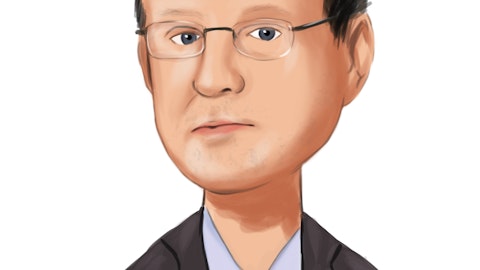Old National Bancorp (NASDAQ:ONB) Q4 2022 Earnings Call Transcript January 24, 2023
Operator: Welcome to the Old National Bancorp’s Fourth Quarter 2022 Earnings Conference Call. This call is being recorded and has been made accessible to the public in accordance with the SEC’s Regulation FD. Corresponding presentation slides can be found on the Investor Relations page at oldnational.com and will be archived there for 12 months. Management would like to remind everyone that certain statements on today’s call may be forward-looking in nature and are subject to certain risks, uncertainties, and other factors that could cause actual results or outcomes to differ from those discussed. The company refers you to its forward-looking statement legend in the earnings release and presentation slides. The company’s risk factors are fully disclosed and discussed within its SEC filings.
In addition, certain slides contain non-GAAP measures, which management believes provide more appropriate comparisons. These non-GAAP measures are intended to assist investors’ understanding of performance trends. Reconciliations for these numbers are contained within the appendix of the presentation. I’d now like to turn the call over to Old National’s CEO, Jim Ryan for opening remarks. Mr. Ryan, please go ahead.
James C. Ryan III: Good morning. Earlier this morning, we reported strong fourth quarter earnings, which put an exclamation point on an incredible year for Old National, one that saw the closing of our transformational merger with First Midwest, successful completion of all related systems conversions, tremendous client growth, and strong talent retention and attraction. The strength of our combined franchise is evident in the results outlined on Slide 4. Adjusted EPS was $0.56 per common share, representing a 10% increase quarter-over-quarter with a strong adjusted ROA and ROATCE of 1.46% and 26.5% respectively. Our efficiency ratio was a record low of 47.5%. I’m pleased to share that we achieved the quarterly expense run rate necessary to fulfill our 109 million of modeled merger expense savings.
Moving to Slide 5, we reported GAAP earnings for the entire year of $1.50 per common share. Our adjusted EPS was $1.96 per common share, representing a 13% increase over 2021. These robust quarterly and annual results with peer leading returns were driven by a focused execution on our successful merger, maintaining our strong low-cost deposit franchise, growing loans with consistent strong credit standards, and disciplined expense management. We were also pleased that the policy balances remained relatively flat for the year, excluding the recent sale of HSA deposits, while maintaining our deposit pricing discipline with a low 12% deposit beta cycle to date. Another highlight of the year is our continual investment in top revenue generating talent across our footprint.
Our story resonates well with these individuals and our talent pipeline remains robust. You may have seen our recent press release last week with the official launch of our 1834 high net worth wealth management brand. This is a fantastic opportunity to leverage our combined franchises strength and recent talent investments. We are already adding new clients to 1834. As we look forward, we feel good about 2023 and expect loan portfolios to continue to grow, albeit not at 2022 pace. In other areas, it should be more the same, below peer deposit costs that drive a funding advantage, more organic growth in our wealth management client base, a continued focus on a disciplined expense management. While we don’t see anything meaningful on the horizon that gives us cause for concern on credit, we know that our granular portfolio, attention to client selection, and consistent underwriting guidelines as well as their active approach to credit management will serve us well if the economy turns worse.
In other words, we intend to stay on the offense, but we are well positioned to withstand any new challenges that lie ahead. Thank you. I will now turn the call over to Brendon for further details.
Brendon B. Falconer: Thanks Jim. Turning to the quarter’s results on Slide 6, we reported GAAP net income applicable to common shares of $197 million or $0.67 per share. Reported earnings include a $91 million pre-tax gain from the sale of our HSA business, which was partially offset by $27 million in pre-tax property optimization charges and $20 million in pre-tax merger related charges. Excluding these items as well as debt securities losses, our adjusted earnings per share was $0.56. Slide 7 shows the trend in total loan growth excluding PPP loans. Total loans grew $606 million, led by commercial growth of $438 million and consumer growth of $168 million. Both commercial and consumer grew an annualized 8%. The investment portfolio decreased by 1% quarter-over-quarter due to reinvestment of portfolio of cash flows in support of loan growth.
We expect $1.1 billion in total investment cash flows over the next 12 months. Slide 8 provides further details of our commercial loans and pipeline. The strong fourth quarter growth was well distributed with 8% annualized growth in C&I and 7% in CRE. Q4 production puts some pressure on the pipeline, but loan demand remains healthy and we expect continued organic loan growth in the mid-single-digit range. Turning briefly to pricing, new money yields on C&I increased 92 basis points from Q3 to 6.21% with new CRE production yields up 131 basis points to 5.86%. We’ve maintained our pricing discipline throughout the rate cycle and are pleased that our spreads have remained stable. Slide 9 shows details of our Q4 commercial production. The $2.7 billion of production was well balanced across all product lines and major markets.
In addition, all of our product segments posted quarter-over-quarter balance sheet growth. We are pleased with the contribution from our newest LPO markets, which contributed almost $200 million in production this quarter. Moving to Slide 10, average deposits excluding the HSA sale were down to 1% quarter-over-quarter with the mix of our non-interest bearing deposits stable at 35%. End of period deposits were impacted $382 million related to the HSA sale and an additional $400 million in seasonal public fund outflows. End of period deposits also reflect the beginning of the mix shift from interest bearing transaction accounts into time deposits. Our loan to deposit ratio combined with wholesale funding capacity and of asset liquidity in the form of our investment and indirect books provides us flexibility in this competitive deposit market.
That said, we are actively defending deposit balances through competitive rates and pricing exceptions. We are also playing offense through various deposit specialists throughout our footprint. We are pleased with our execution of this strategy today as we have been able to generate new deposits sufficient to maintain stable overall balances. Market conditions have put upward pressure on deposit rates with average total deposit costs up 22 basis points quarter-over-quarter to a still very low 34 basis points. Interest bearing deposit cost increased to 52 basis points, resulting in an industry-leading cycle to date beta of 12%. Our granular low cost deposit base should continue to give us a funding advantage throughout the remainder of this rate cycle.

Photo by Vardan Papikyan on Unsplash
Next on Slide 11, you will see details of our net interest income and margin. Both metrics exceeded expectations, largely due to the outperformance of our deposit beta assumptions. Net interest margin expanded 14 basis points quarter-over-quarter to 3.85%, with core margin excluding accretion up 30 basis points to 3.75%. Slide 12 provides additional details on our asset liability position and projected margin range. Core margin for Q1 is expected to be in line with Q4 taking into account the six basis points of margin decline related to day count. Our outlook assumes deposit betas increasing from 12% today to a cycle to date beta in the first quarter of 20%. The assumptions in our outlook also included Fed funds target rate of 5% and a 4% yield on 10 year treasuries at the end of the first quarter.
Specific margin guidance is challenging beyond Q1, but assuming the Fed cost is in Q2 and deposit repricing persists, we would expect pressure on margin in the back half of 2023. Also, while we remain well positioned for rising rates, we have been proactively adding downgrade protection, including an additional $400 billion of new hedges this quarter with an average floor strike of 4%. Slide 13 shows present adjusted noninterest income, which was $74 million for the quarter. This was generally in line with our expectations as market conditions continue to put pressure on mortgage and wealth revenues. The linked quarter decrease was also impacted by lower capital markets fees, which reflect lower demand for interest rate swap products given the rate environment.
Fees were also impacted by one month of service charge enhancements implemented in December that were discussed last quarter. Again, we estimate approximately $5 million annual impact from service charge enhancements. Next, Slide 14 shows the trend in adjusted noninterest expenses. Adjusting for merger charges, property optimization charges, and tax credit amortization, noninterest expense of $230 million and our adjusted efficiency ratio was at historically low 47.5%. Expenses decreased $7 million quarter-over-quarter due to lower salaries and data processing expenses. Expenses were higher than anticipated due to $5 million quarter-over-quarter increase in incentive accruals given our strong earnings performance for the year. Excluding incentive adjustments, we are pleased to report that we have achieved a quarterly expense run rate consistent with our modeled cost synergies.
We thought it would be helpful to provide additional detail on our 2023 expense outlook. We believe $225 million of the correct quarterly run rate to build off for your 2023 models. From this $900 million annualized base, we anticipate annual impact of $14 million in tax credit amortization, $11 million for merit, an incremental increase in FDIC expenses of $9 million, and approximately $10 million in strategic investments in both talent and technology enhancements. These investments will be partially funded with approximately $5 million in expense saves from the real estate optimization actions taken in Q4. Slide 15 shows our credit trends. Credit conditions are stable, and our commercial and consumer portfolios continue to perform exceptionally well.
Net charge-offs were modest five basis points. Our special assets team is continuing to work through our PCD loans and expect charge-offs from this portfolio to increase but with variability from quarter-to-quarter. The provision expense impact from this effort should be minimal as we carry $59 million or approximately 5% reserve against the PCD book. On Slide 16, you will see the details of our fourth quarter allowance, including reserves for unfunded commitments, which stands at $336 million, up $8 million over Q3. Note that during the quarter, we reclassified both current and prior quarter allowance for unfunded commitments from noninterest expense to provision. Allowance for credit loss totals and metrics now include the allowance for unfunded commitments providing a more complete view of our allowance levels.
This accounting treatment is also more consistent with peers and should aim at comparability. Reserve build was driven primarily by strong loan growth with relatively small increases due to portfolio mix, partly offset by improvement in our economic forecast. The financial health of our clients remain strong, and while credit metrics are stable, we believe it is prudent to maintain elevated reserves given the uncertainty in our base case economic outlook. Our current reserves reflect a relatively severe economic scenario, including negative GDP of 3.6% and unemployment of 7.2%, which is at the top end of our supportable range. Unless the economic outlook deteriorates materially, 2023 provision expense should be limited to portfolio performance and loan growth.
In addition to the $336 million in reserves, we also carry $102 million in acquired loan discount marks. Slide 17 provides details on our capital position at quarter end. Capital ratios improved across the board. Our CET1 ratio grew to a very healthy 10% and our TCE ratio increased 36 basis points to 6.18%. Total OCI was stable quarter-over-quarter but is still impacting our TCE ratio by 155 basis points. We continue to monitor our balance sheet for economic stress and feel very comfortable with our capital levels. As I wrap up my comments, here are some key takeaways. We ended a transformational year for ONB with fantastic full year results and an even better fourth quarter. Adjusted EPS grew 10% and tangible book value per share grew 8% in the quarter.
Key profitability ratios also improved from very strong Q3 results with an adjusted return on tangible common equity of 26.5% and return on average assets of 1.46%. We posted another solid quarter of quality organic loan growth and defended our deposit base well. Net interest income improved $15 million with 30 basis points of core margin expansion and an industry-leading cycle-to-date deposit beta of 12%. We are also pleased to have achieved a quarterly expense run rate consistent with our modeled merger cost synergies, resulting in a record low efficiency ratio of 47.5%. Slide 18 includes thoughts on our outlook for 2023. We believe commercial sentiment and our year-end pipeline supports mid-single-digit loan growth in 2023. Net interest income and margin should be consistent with the guidance we outlined earlier, with pressure from deposit repricing in the back half of the year.
We expect our fee businesses to continue to perform well despite headwinds with mortgage following industry patterns. While our wealth business will be subject to market volatility, we are beginning to see revenue momentum from the strategic hires we’ve made over the last 18 months. Capital markets revenue was under pressure and should perform consistent with Q4 levels. Service charge changes implemented in December that are largely consistent with industry best practice, will impact full year 2023 by approximately $5 million. Our expense outlook is consistent with guidance we outlined earlier. Turning to taxes. We expect approximately $14 million in tax rate amortization for 2023 with a corresponding full year effective tax rate of 24% on a core FTE basis and 22% on a GAAP basis.
With those comments, I’d like to open the call for your questions. We do have the full team available, including Mark Sander, Jim Sandgren and John Moran.
See also 13 Largest Gold Mines in the World and 25 Strongest Countries in Europe by Military Power.
Q&A Session
Follow Old National Bancorp (NASDAQ:ONB)
Follow Old National Bancorp (NASDAQ:ONB)
Operator: Thank you. . Our first question today comes from the line of Ben Gerlinger with Hovde Group. Ben, please go ahead.
Benjamin Gerlinger: Hey, good morning everyone.
James C. Ryan III: Good morning Ben.
Benjamin Gerlinger: I appreciate the guidance that you guys gave on expenses and the waterfall is really helpful. When you think about 2023, I think, obviously, everyone is a little bit more skeptical in economic outlook. When you think about hires, I know that, that’s kind of a priority longer term and investment in the company, taking decades rather than quarters, but — is there any way you would possibly slow because you don’t necessarily want to hire lenders going into a recession or any type of lending that you’re really looking to lean into?
James C. Ryan III: Ben, I just think there’s great opportunities for us to tell our story. When we get those opportunities and people are interested, I think we’re always going to have a place for top talent. And Mark Sander said this really well, top talent will pay for itself. So while we’ll be thoughtful and deliberate about all of our new hires, I think when given the opportunity to attract — I mean, this is really the top quartile, top decile of each of the marketplaces. We’re going to go ahead and hire those folks. But again, we’ll be thoughtful if the economic outlook looks materially different than what we look at it today. We’re going to be thoughtful about adding expenses and we’ll be diligent about looking at ways to reduce costs as well. So — but at this point in time, I just don’t see anything different than the plan, which is to go ahead and attract the best possible talent we can to the organization.
Benjamin Gerlinger: Got you. That’s fair. And then obviously, hires just broadly speaking, in front of lenders. So when you think about the fee income line items, there’s a lot of moving parts and a lot of different businesses. I know the recently announced wealth management is a big positive. But obviously, you guys can’t project the full year fee income with mortgage as a volatile factor in that. But when you think about it, are we out of floor in mortgage and from here, do you think fee income rebounds holistically?
James C. Ryan III: Let me give you a 50,000-foot view, and then I’ll have our CFO jump in. I’d like to think that mortgage doesn’t get much worse than where we’re at today, right. And a lot of the balance sheet — a lot of the production we’re doing today hits our balance sheet, not the fee income line. In terms of wealth, the good news is we’re basically taking our business and dividing it into a couple of different businesses and 1834 is one of those businesses, right. There’s not a big increase needed to staff that. And I would say that the talent we’re looking for is both on the commercial side, business banking, but also the wealth management side. That’s a big part of where we’re heading. The good news is we have all the talent we need to get 1834 off the ground and running at a high level.
So there’s not a big required investment there. We do have high expectations that, that will grow kind of above our historic norms in that business despite what market conditions there — market conditions are going to be what they’re going to be. But nonetheless, we have pretty high expectations around our ability to grow that organically.


